A new backbone for the regional transit system: merging the MARC Penn and VRE Fredericksburg Lines
From Public transport -- Plannng the networks (HiTrans Best Practice Guide #2):
Exploit the network effectOne way to lay the groundwork for the creation of the DMVTA, the DC-Maryland-Virginia Transport Association, a new regional transit planning, management, contracting, marketing, and operational authority modeled after the German Verkehrsverbund, is to merge the MARC Penn and VRE Fredericksburg Lines into a single integrated passenger railroad service.
When the aim is to compete with the motorcar for travel in urban regions two crucial qualities of the system are: short waiting times between departures; and an integrated network of services between all areas of significant transport demand. A system without these two qualities can never be a real competitor to the car as the main mode of transport.
Therefore network planning must find ways to concentrate resources to a sufficient number of high frequency lines that form a travel network that caters for a major part of the demand for motorised transport in the city region. (page 13)
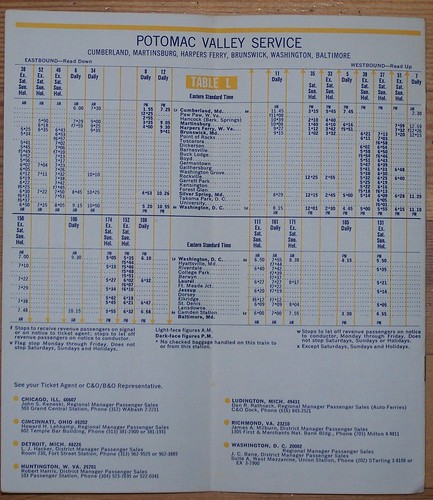 Today's services are based on services once provided by private railroad companies. Historically, commuter passenger railroad services focused on DC and Maryland, with services offered by the B&O (Brunswick and Camden Lines) and Pennsylvania (the Penn Line) Railroads.
Today's services are based on services once provided by private railroad companies. Historically, commuter passenger railroad services focused on DC and Maryland, with services offered by the B&O (Brunswick and Camden Lines) and Pennsylvania (the Penn Line) Railroads. In Virginia, regular commuter services in what we now call the I-95 corridor were made at Alexandria, Quantico, and Fredericksburg on the Richmond, Fredericksburg, and Potomac Railroad, as well as by available by piggybacking on passenger trains traveling further south.
Service to Manassas was provided by the Southern Railway (now part of Norfolk Southern, which owns the track used by VRE on the Manassas Line).
When the area railroads gave up their passenger railroad services, the State of Maryland stepped in to maintain Maryland-based services, creating the MARC system.
In Virginia, when passenger railroad services were devolved to Amtrak, the state did not step in. Although in the 1980s, planning began which led to the creation of the Virginia Railway Express system, which launched service in 1992
Doesn't it make sense to have one combined system? In other cities--New York and Connecticut, Philadelphia, Chicago, Boston--commuter railroad services that had been delivered by multiple railroads have been combined into a unified public sector railroad system. (NJ Transit provides service to Philadelphia and New York City separately from NYC and Philadelphia based services.)
Based on a concept first put forward by Dan Malouff of BeyondDC, for more than a decade, I've recommended merging the MARC (Maryland, DC, West Virginia) and Virginia Railway Express (VRE; Virginia, DC) into one combined system,
I call the merged system RACER, for Railroad Authority of the Chesapeake Region.
-- "Regional transportation planning and fixed rail service," 2009
-- "Why don't Maryland and West Virginia think about expanding MARC into a true regional system?," 2012
-- More on Union Station DC and the need for innovative master planning," 2012
-- DC State Rail planning," 2015
In, "One big idea: Getting MARC and Metrorail to integrate fares, stations, and marketing systems, using London Overground as an example," while focusing on MARC, I called for tighter integration of fare media, service patterns, and marketing of heavy rail and railroad passenger transit. The same points pertain to VRE.
Conceptual maps Dan created shows how such a system could provide service throughout the multi-state region, with service to Delaware and even south to Richmond, even if there are now what I consider service gaps in the concept (e.g., Southern Maryland, between Frederick and Baltimore, etc.).
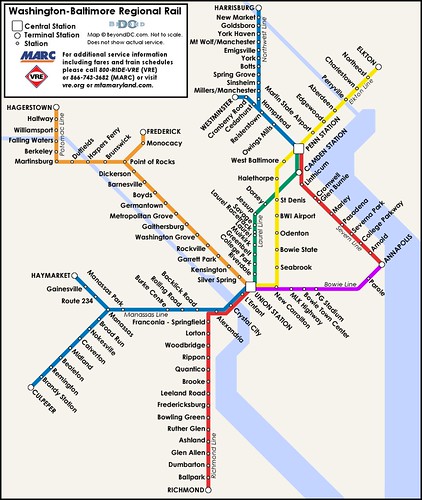
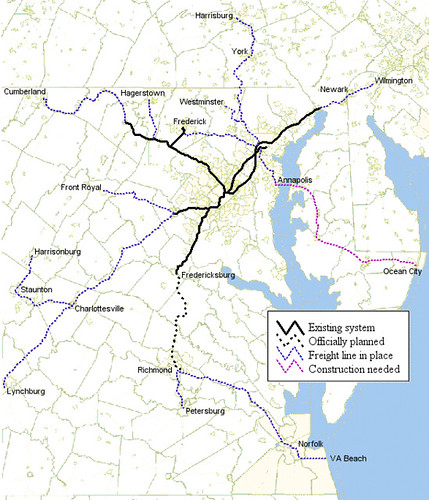
Maps by Dan Malouff, BeyondDC
MARC looking to continue service to Newark, Delaware. In fact, talks are underway between Maryland, Delaware, and Pennsylvania on the possibility of extending the MARC Penn Line to Newark, Delaware, where it would connect to the SEPTA railroad commuter system.
According to the Wilmington News-Journal ("Maryland trains to Newark inch closer"), either MARC could extend from Perryville to Newark, or alternatively, SEPTA could extend from Newark to Perryville. And service could start in about three years.
Conceptual Future integrated rail transit service network for the Washington DC National Capitol Region. Design by Paul J. Meissner. Concept by Richard Layman and Paul Meissner.

Commuter versus passenger railroad services. The difference between a "commuter railroad" and a "passenger railroad" is that the first is oriented to service during the morning and evening rush periods, Monday through Friday, serving commuters. By contrast a passenger railroad system provides service throughout the day and night, in both directions.
Why not build a regional passenger rail system with the MARC Penn and VRE Fredericksburg Lines? In the back and forth with Paul Meissner about what to go in the "fantasy map"-- pictured above -- what an ideal integrated rail transit network could look like in the Washington-Baltimore region, I made a conceptual leap concerning merging of MARC and VRE.
Rather than focus initially on "merging" the entire system, why not focus on merging the two main lines NOW, as a precursor to a complete merger in the future.
These two lines--the MARC Penn Line and the VRE Fredericksburg Line--are the highest use lines and serve the most in-demand origins and destinations in the regional passenger rail transit system.
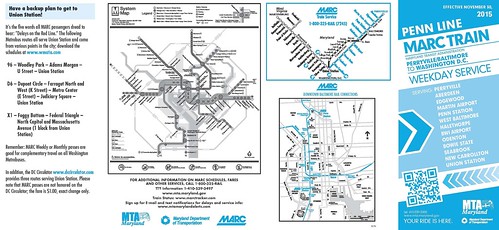
Both lines are part of the same railroad main line along the Atlantic Ocean coast, a set of railroad lines that go from north of Boston to Florida.
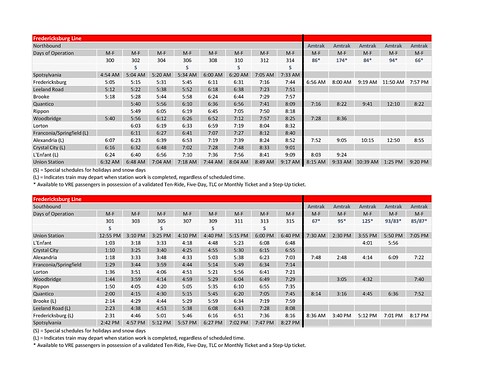
In the legend for the Concept Future Transit Map, MARC lines are brown and VRE lines are green. The combination of the Penn and Fredericksburg Lines is shown on the map as a hatched brown-green line.
Examples from New York, Connecticut, Rhode Island, and Delaware. Note that in New York-Connecticut, the old New York, New Haven Railroad main line in Connecticut is run by New York State's Metro-North Railroad, on a contract basis. (MBTA also runs some service to Rhode Island on contract.) And the two Metro-North Lines west of the Hudson River emanating from Penn Station are run by NJTransit on contract, even though both railroads separately market each line.
-- West of Hudson Lines; Metro-North
-- Main-Bergen Line (to Port Jervis), Pascack Valley Line (to Spring Valley); NJ Transit
The State of Delaware pays SEPTA for service to Wilmington and Newark (Wilmington-Newark Regional Railroad Line).
Advantages to merging the lines. First, it would reduce the amount of equipment required overall. Second, it would reduce the amount of equipment that needs to be stored, because the combined Penn-Fredericksburg Line would run throughout the day. Right now, VRE mostly runs each train in a single direction--to DC in the morning, and back to Virginia in the evening.
Third, merging the lines would ease congestion on WMATA and/or roads, because a significant number of MARC passengers transfer to reach their ultimate destinations, and many of these trips, especially to L'Enfant Plaza and Crystal City, could be served fully by train if there was unified service.
It would significantly increase the appeal of railroad transportation as a commuting choice to DC and Maryland residents seeking to reach destinations beyond Union Station. Having Fort Belvoir and Fort Meade on the same railroad line could be an advantage also.
Fourth, the line would connect two of the region's three airports--National Airport and BWI. Although as pointed out "A brief comment on ground transportation at National Airport vis a vis VRE rail service," there would need to be significant upgrades to the Crystal City station to accommodate this.
With more frequent transportation options and better integration of the station into the National Airport ground transportation system, use of the airport would be facilitated for residents south of the Airport, and could reduce road congestion as well.
Fifth, it could facilitate the integration of the SmarTrip fare media system with at least the Penn-Fredericksburg Line.
Barriers to merger. The first thing that people are likely to say is that VRE and MARC use different equipment. That's true. While MARC passenger cars can use either high or low platforms, VRE trains can only use low platforms.
Wikipedia photo of a VRE train on the Long Bridge.
Second, the most significant barrier is limited capacity to cross the Potomac River. Right now there are two tracks across the Long Bridge, and they are owned by CSX, not Amtrak.
A big reason that VRE trains aren't bi-directional has to do with high demand for access to the tracks, which is a heavily used freight transportation line. However, planning to expand the bridge is underway, with the addition of two tracks to facilitate more passenger rail service.
Third, because the VRE system is set up to run unidirectionally, stations don't have platforms on both sides of the tracks. Although the VRE system expansion plan (VRE System Plan 2040) is addressing various station capacity and design issues, to accommodate bi-directional service.
Fourth, outside of Crystal City and to some extent Alexandria, there isn't that much demand for bi-directional service between Baltimore, DC and Northern Virginia. Oddly enough, because of the cost of storing trains at Union Station and the limited space there, it is cheaper in some ways to run an all-day service than to store the train.
Over time, with marketing and changes in land use and intensification to favor locations served by the railroad, this is likely to change.
Fifth, another barrier may be the train track connections/capacity between the Penn Line, Union Station, and the Virginia Avenue Tunnel and railroad tracks.
Sixth, electrification is an issue. Theoretically, MARC Penn Line trains are electrified, and VRE trains are not ("Dual powered diesel-electric locomotive introduced into service at NJ Transit and implications for long range regional railroad planning in DC, Maryland, and Virginia"). However, MARC has been switching to diesel trains for the Penn Line, because of cost reasons. For various sustainability reasons, that isn't necessarily a preferred choice.
However, it works in terms of unifying the Penn and Fredericksburg Lines at least in the intermediate run. At this time, Virginia is not interested in paying to electrify the tracks between DC and Richmond. In any case, it is possible to have dual powered locomotives, capable of working on either electrified or non-electrified tracks.
Labels: change-innovation-transformation, fixed rail transit service, provision of public services, railroads, transit marketing, transportation planning, urban design/placemaking






14 Comments:
great piece last night on McNeil Lehrer Report that interviewed or followed the head of Amtrak as he took a train up the seaboard and how incredibly obsolete our rail infrastructure is- basically there are two tracks going under the Hudson and much of the NE corridor has not added any capacity since the Civil War. Its rather terrible when one considers how advanced our rail system got to be in the USA and then was allowed to decay and languish.
yep. It's amazing to think of how in passenger rail and rail-based transit (streetcars), the US was the world leader.
A few weeks ago there was an "American Experience" called "the race underground" based on a book of the same title.
While the book focused on "the race between NYC and Boston" to have the first subway, the tv show focused on Boston being the first place to have a subway AND on Frank Sprague.
I knew Frank Sprague "created the first electric trolley system in Richmond." But I didn't know the details, what a tough job it was, how he had 90 days to do it or he wouldn't get paid, how he made some key technological advances (including putting the motor in the wheels/trucks of the car with hydraulics so they could move up and down with the terrain, keeping the wheels connected to the electric conducting equipment), and how I had never thought about the basic technologies of streetcars being the precursor necessary for underground electric-powered transit. (WRT the latter, I don't think Sprague invented "third rail" power systems, which was a later development.)
Plus I never thought about how underground transit was a key element of the making of the modern mind in that people had to throw off beliefs in the devil etc. being underground, in order to comfortably use transit located "below grade."
I've since picked up the book but haven't read it yet.
Sadly, Sprague was undercapitalized and so GE bought his company, and renamed all the equipment after GE.
There is a good book on the building of Penn Station, which is about building the tunnels to the station too.
https://www.amazon.com/Conquering-Gotham-Building-Station-Tunnels/dp/0143113240
That's an achievement dating more than 100 years old too.
It's pathetic we have to wait for a weather event like Superstorm Sandy to muster commitment to the reinvestment necessary to make those tunnels work for another 100 years.
If I'm reading the Potomac Service table correctly, the 1969 trains appear to be faster now than their present-day MARC equivalents. There does not appear to be a single Camden line train that gets to Baltimore under an hour. Not to mention the current lack of reverse-commute service toward Harpers Ferry. Thank you for the article and the neat map!
FYI
https://www.bloomberg.com/news/articles/2017-03-10/paris-big-dig-abandons-chic-haussmann-for-trains-to-the-suburbs
Camden still takes an hour now. But it is reliable. The express MARC train gets to Baltimore from DC in 35 minutes. But they only have one or two of those, it's more to get back fast to pick up more people to go back to DC.
2. WRT bi-directional service on the Brunswick Line, I probably should have mentioned that issue separately as part of the "historical service patterns" point at the front of the entry.
Think of what Montgomery County was like back then. There was little reason for DC residents to want to get to White Flint, Rockville/I-270, Gaithersburg, Germantown, or Frederick for jobs back then. That isn't the case today.
But how it was "back then" shapes today's service pattern.
My cited London Overground piece talks about most of those issues, the opportunities present within MARC.
3. WRT the fantasy map, I'll be writing more about it. A few posts probably.
Maybe Paul Meissner will agree to do a fantasy map only for railroad service, building on the Dan Malouff map from the 1990s.
Dan's map doesn't have service to Charles County (back then they were thinking of light rail and planning for it), or between Frederick and Baltimore, or to Newark/Wilmington.
And the DC State Rail Plan process identified some railroad opportunities in the Southeast quadrant too. But I haven't read the final draft.
In this map, because of discussions in the State Rail Plan, we added a railroad stop at Fort Totten, not because of demand but for redundancy vis a vis closures at Union Station (Fort Totten station is also served by the Green Line), and some stations in northeast DC.
If we were considering Maryland, I'd probably have asked for a Camden line station in Hyattsville?
charlie -- thanks for cite.
here's one you've probably seen:
https://www.theatlantic.com/business/archive/2017/03/gentrification-moskowitz/519057/
you mentioned this same point/concept/interpretation as an issue with London and a downside from being a global city.
I'll try to get a review copy.
2. any movement on that other thing (visioning)?
Thanks for that article. we have discussed that project before... it really is on an incredible scale. I think that's the kind of big thinking that influences this idea of the fantasy map.
that being said, Paul and I didn't agree on everything and he also had the discipline of not merely being willing to draw a line on a map.
I lost on some things, which I will discuss in the various write ups.
I still believe in two of the things I lost on, but on one at least (blue line, which I was gonna disconnect from Downtown) he makes very good points about the importance of the "one seat ride" and how that would require most people traveling from the SW side of NoVA to make a transfer to get into Downtown.
Had he done the new blue line the way I wanted, it would have crossed into Georgetown and then go up Wisconsin, and then cross over to go up Connecticut.
But those legs would have required transfers too.
2. but speaking of "drawing lines," the other is to draw lines without the constraint of potential funding. I can draw lines to my heart's content, bu practical reality in terms of potential-theoretical funding capacity is another story entirely.
it's why your point about WMATA getting dedicated funding vs. "transit" getting dedicated funding is so important.
the one seat ride is why Dave Murphy's yellow line concept had to be modified.
He started switching it at L'Enfant Plaza, which would require most everyone going to/from National Airport to transfer.
I suppose they have to anyway, to get to blue/orange/silver and red in the city, but I didn't think L'Enfant was a good place to make that change.
"Fifth, it could facilitate the integration of the SmarTrip fare media system with at least the Penn-Fredericksburg Line."
Nope.
That would be lovely, as I have both the Charmcard and SmartTrip, but with the current layout and system, paper is going to rule. There doesn't appear to be a mobile meter a conductor can carry on his/her person to do ticketing.
I've been on Baltimore's yellow line many times and cannot figure out for the life of me how to pay for the darned thing. Once someone came on to check fares. Everyone else pulled out paper tickets, all I had to do was flash my blue plastic Charm card. She just waved her hand at me. I'm guessing she didn't have anything to check my card to see if there was anything on it.
This column in the Boston Globe discusses potential cuts in weekend passenger rail service, making the point that the transit system is "world class" only five days/week.
https://www.bostonglobe.com/opinion/2017/03/15/world-class-city-five-days-week/LBdlDQjygYHkVFf1LSiXYM/story.html
https://www.washingtonpost.com/transportation/2023/04/13/marc-maryland-commuter-trains-virginia/
"Maryland advances plan for MARC train service to Virginia, Delaware"
Very many years away. Requires significant infrastructure improvements. But at least it's on the agenda.
VRE is considering Saturday service starting FY2024.
Virginia Railway Express Weekend Service, Fare Increases Proposed
https://patch.com/virginia/oldtownalexandria/virginia-railway-express-weekend-service-fare-increases-proposed
The preliminary proposal calls for three round trips on each of the Manassas and Fredericksburg lines. That would total 12 one-way trips on Saturdays, compared to 32 one-way trips on weekdays.
Saturday service must also be approved by the hosting railroads and other stakeholders. The start date of weekend service would depend on agreements with VRE's three host railroads.
Parent agencies of Virginia Railway Express approve funding to purchase Manassas Line
https://www.trains.com/trn/news-reviews/news-wire/parent-agencies-of-virginia-railway-express-approve-funding-to-purchase-manassas-line/
3/9/25
Post a Comment
<< Home